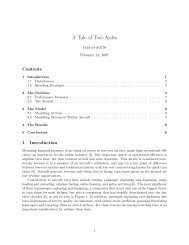Neural Models of Bayesian Belief Propagation Rajesh ... - Washington
Neural Models of Bayesian Belief Propagation Rajesh ... - Washington
Neural Models of Bayesian Belief Propagation Rajesh ... - Washington
You also want an ePaper? Increase the reach of your titles
YUMPU automatically turns print PDFs into web optimized ePapers that Google loves.
236 11 <strong>Neural</strong> <strong>Models</strong> <strong>of</strong> <strong>Bayesian</strong> <strong>Belief</strong> <strong>Propagation</strong> <strong>Rajesh</strong> P. N. Rao<br />
11.2 <strong>Bayesian</strong> Inference through <strong>Belief</strong> <strong>Propagation</strong><br />
Consider the problem <strong>of</strong> an animal deciding whether to flee or keep feeding<br />
based on the cry <strong>of</strong> another animal from a different species. Suppose it is <strong>of</strong>ten<br />
the case that the other animal emits the cry whenever there is a predator in the<br />
vicinity. However, the animal sometimes also emits the same cry when a potential<br />
mate is in the area. The probabilistic relationship between a cry and its<br />
probable causes can be captured using a graphical model as shown in figure 11.1.<br />
The circles (or nodes) represent the two causes and the observation as random<br />
variables R (Predator), M (Mate), and C (Cry heard). We assume these random<br />
variables are binary and can take on the values 1 and 0 (for “presence” and<br />
“absence” respectively), although this can be generalized to multiple values.<br />
The arcs connecting the nodes represent the probabilistic causal relationships<br />
as characterized by the probability table P (C|R, M).<br />
Predator (R) Mate (M)<br />
Cry Heard (C)<br />
Figure 11.1 An Example <strong>of</strong> a Graphical Model. Each circle represents a node denoting<br />
a random variable. Arrows represent probabilistic dependencies as specified by the<br />
probability table P (C|R, M).<br />
For the above problem, the decision to flee or not can be based on the posterior<br />
probability P (R|C) <strong>of</strong> a predator given that a cry was heard (C = 1). This<br />
probability can be calculated directly as:<br />
P (R = 1|C = 1) = <br />
P (R = 1, M|C = 1)<br />
M<br />
= <br />
kP (C = 1|R = 1, M)P (R = 1)P (M), (11.1)<br />
M<br />
where we used Bayes rule to obtain the second equation from the first, with k<br />
being the normalization constant 1/ <br />
R,M P (C = 1|R, M)P (R)P (M).<br />
The above calculation required summing over the random variable M that<br />
was irrelevant to the problem at hand. In a general scenario, one would need<br />
to sum over all irrelevant random variables, an operation which scales exponentially<br />
with the total number <strong>of</strong> variables, quickly becoming intractable. Fortunately,<br />
there exists an alternate method known as belief propagation (or prob-
















